Installing GainSeeker client version 8.8
Before installing
Where to install
-
-
When installing GainSeeker on a traditional client/server network, you should install GainSeeker at all client workstations, not at the server itself.
-
When installing GainSeeker on a terminal server with Citrix or Terminal Services, you must run the GainSeeker installation at the terminal server.
-
When installing GainSeeker on a web server or intranet server for use with GS Analyze or GainSeeker Mobile Web Service, you must run the GainSeeker installation at the web server or intranet server.
Permissions required
System Requirements
Client must meet the System Requirements, including:
Copy the GainSeeker Installation CD and configure Setup.ini (optional)
Recommended practice is to copy the installation CD (or the \SPC\DISK1\ folder) to a local drive on the client before running the installation. Alternately, a network drive can be used.
 Note: If you run the client installation from a network folder, it may be necessary to run it as a Domain Administrator or log in to the client operating system as a Domain Administrator (depending on the security settings for your network). If you run the client installation from a local drive, Local Administrator permissions are usually sufficient.
Note: If you run the client installation from a network folder, it may be necessary to run it as a Domain Administrator or log in to the client operating system as a Domain Administrator (depending on the security settings for your network). If you run the client installation from a local drive, Local Administrator permissions are usually sufficient.
Configure Setup.ini (optional)
You can edit \SPC\DISK1\Setup.ini to specify the shared data folder for step 3 below.
If GainSeeker is not already installed on the client, but the Setup.ini is configured with a config_path, the installer will automatically detect this information and will not display that step. (If GainSeeker is already installed on the client, the local Cms.ini file will already contain a config_path and this Setup.ini file will not be used.)
Review command line parameters
To view available command line parameters for the installation program, run \SPC\DISK1\SETUP.EXE /? .
Current parameters for the installation include /LOG:"filepath\filename" for minimal logging (including Msi error codes), /LOGMSI:"filepath\filename" for verbose logging, and /Q to run the installation silently. You can specify any combination of these parameters, if desired.
If the installation does not detect all of the settings shown in the steps below, it will display a prompt for the user to enter the missing information - even in silent mode.
Close all GainSeeker modules (if upgrading)
If GainSeeker data already exists on your network, you may need to have some or all network users exit all GainSeeker modules before you can successfully install this version of GainSeeker:
-
-
-
When installing this version of GainSeeker on a workstation, you must close all GainSeeker modules before launching the installation.
-
When using GainSeeker on terminal server with Citrix or Terminal Services, all GainSeeker users must close all GainSeeker modules before you install this version of GainSeeker. If any of the shared files on the terminal server are locked when you try to install GainSeeker, the installation cannot be successfully completed.
Update shared Cms.ini on Terminal server (if upgrading)
If upgrading from GainSeeker version 8.7 or previous, on a Citrix or Terminal Services implementation where users are assigned their own Home directories, it is recommended that you edit the Cms.ini file in the shared Windows folder and remove the physid= setting (if present).
Do not Uninstall previous versions
Do not uninstall previous versions of GainSeeker before installing GainSeeker v8.8.
Performing the installation
Launching the installation
From the GainSeeker installation CD - or from a local or network copy of the CD - run \SPC\DISK1\SETUP.EXE (with or without command line parameters).
Windows that may appear during the installation
Step 1

In silent mode, this step will not be displayed.
Step 2
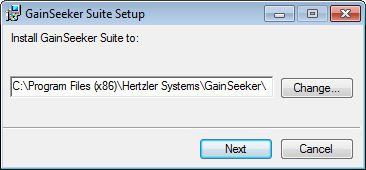
Choose a folder for the GainSeeker program files.
In silent mode, the default folder will be used, and this step will not be displayed.
Step 3
If GainSeeker is already installed on this client, the installer will automatically detect this information and will not display this step.
If GainSeeker is not already installed on this client, but the Setup.ini is configured with a config_path, the installer will automatically detect this information and will not display this step.
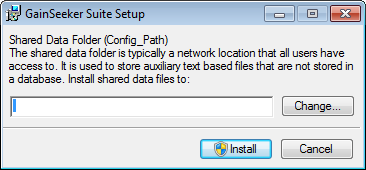
Specify a network file path where shared data files exist (or should be placed).

If the folder you specify does not exist, the installation program will attempt to create it for you.
The path you specify will become the config_path= setting in Cms.ini on this workstation.
Step 4

In silent mode, this step will not be displayed.
Set up Database Connection
If GainSeeker is already installed on your network, the installer will automatically detect this information from the file path on step 3 and will not display this step.

Click the Database Provider list and select the provider that is appropriate for your GainSeeker database:
|
GainSeeker database:
|
Data Provider:
|
|
SQL Server
|
SQLClient
|
|
MySQL
|
MySQL
|
|
Oracle
|
OracleClient
|
|
Pervasive (database mode)
|
Pervasive PSQL
|
Enter the other information on this screen that is needed to connect to your GainSeeker database.
The fields provided on this screen will vary with the type of Data Provider you selected. For some fields, you can click the  button to fill the list of options and then the drop-down arrow to show the list again. For an Oracle database, the Database server you specify will actually be the Oracle Net Service Name you have set up on the workstation.
button to fill the list of options and then the drop-down arrow to show the list again. For an Oracle database, the Database server you specify will actually be the Oracle Net Service Name you have set up on the workstation.
You can also use the Options box to enter any additional connection string parameters that do not match any of the other fields provided on this screen. More information can be found at the web addresses listed below:
Click Test to test the database connection.
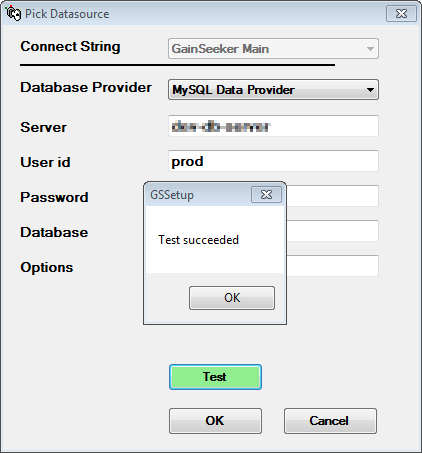
If the test was not successful, you will need to change one or more settings before saving the database connection.
After the database connection has been successfully tested, click OK.
Install License and Serial Number
If GainSeeker is already installed on your network, the installer will automatically detect this information from the file path on step 3 and from the database connection above, and will not display this step.
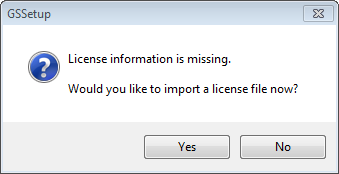
Click Yes, then navigate to the license file that was provided to you (typically named GS_Suite.lic). (If you do not have a license file, you will be prompted again to import it when you try to run a GainSeeker module such as LaunchPad or System Administration.)
After the license file is imported, GainSeeker will display the details of your license and serial number:
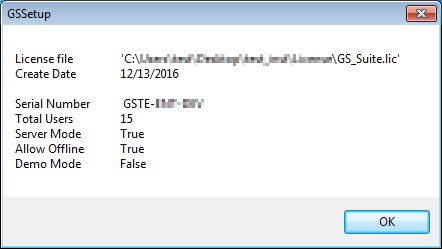
Automatically apply minor changes to database
If you are upgrading from a GainSeeker version prior to 8.4, the following changes may be automatically applied to your GainSeeker database:
After the installation
Additional tasks for Citrix and Terminal Services (if upgrading)
If upgrading from GainSeeker version 8.7 or previous, on a Citrix or Terminal Services implementation where users are assigned their own Home directories, you may need to reset the PhysID= and User_Name= settings for those Terminal Services users. This is because GainSeeker version 8.8 (and later) now sets and reads these three settings in a new user-specific Usershared.settings file and may not be able to read the previous settings from their former location.
Additional tasks for Citrix and Terminal Services (new installation)
In a multisession
application hosting environment such as Citrix and Windows Terminal Services,
it is not necessary to install GainSeeker on additional workstations.
However, you may need to perform one or more
of the following steps after installing GainSeeker on your terminal server:
During installation on Windows Vista (or later), changes may be made to the Cms.ini in the Virtual Store folder instead of the Windows Folder. It is a best practice to copy the Cms.ini file from the Virtual Store folder to the Windows folder. When other Windows users log into that workstation to run GainSeeker, it uses the Cms.ini file in the Windows Folder as a base file, which copies to that user's Virtual Store folder.
Ensuring backups
After installing GainSeeker, ensure that your GainSeeker database and your shared data folder will be backed up regularly.
Do not Uninstall previous versions
Do not uninstall previous versions of GainSeeker after installing GainSeeker v8.8.
Other steps:
 Note: If you run the client installation from a network folder, it may be necessary to run it as a Domain Administrator or log in to the client operating system as a Domain Administrator (depending on the security settings for your network). If you run the client installation from a local drive, Local Administrator permissions are usually sufficient.
Note: If you run the client installation from a network folder, it may be necessary to run it as a Domain Administrator or log in to the client operating system as a Domain Administrator (depending on the security settings for your network). If you run the client installation from a local drive, Local Administrator permissions are usually sufficient.







